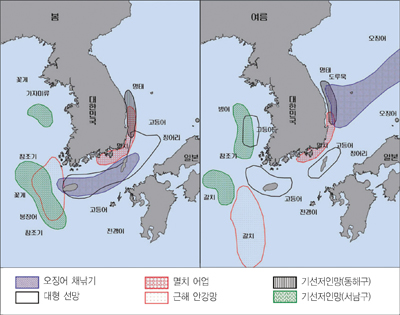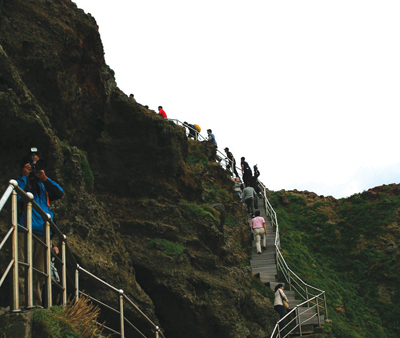- Dokdo in the East Sea
- Educational material
- High School Version
Dokdo in the East Sea
Table of Contents Open Contents
1. Dokdo’s Future
-
- Objectives
-
Understand the inherent value of Dokdo.
Discuss the importance of protecting Dokdo.
-
- Critical Thinking
-
Dokdo’s volcanic characteristics not only give it a unique landscape, its ecosystem is home to rare plant and animal life and underwater resources. What would be the best way to balance resource development of natural gas hydrates, deep ocean water (DOW), and fisheries while conserving its natural environment?
Dokdo’s Underwater Resources
Natural gas hydrates are important development resources in Dokdo. Gas hydrates are methane-rich natural gases that have turned into solids as a result of being surrounded by ice. They can be found in the seabed at depths of 300 meters or more. Other names for natural gas hydrates include hydromethane, methane hydrates, fire ice, and solid clathrate hydrate.
Natural gas hydrates emit less pollution than other fuels, and oil is likely to be found in places where they exist. Gas hydrates have garnered interest as a next generation energy source.
Research conducted in June 2005 indicates that about 600 million tons of natural gas hydrates are buried in the seabed approximately 100 kilometers south of Ulleungdo. This is equivalent to about 30 years of natural gas consumption in South Korea, and its estimated value is $9.4 billion USD annually. However, the material is buried so deep in the sea bed that it is currently not economically feasible to develop as a resource.
There are other possibilities of developing important natural mineral resources other than natural gas hydrates. Over 200 million tons of phosphate minerals are estimated to be buried in the East Sea seabed, as well. Phosphate mineral is a raw material in the production of natural fertilizers, and currently, South Korea imports over 1.5 million tons per year. Buried mineral resources such as natural gas hydrates are an indication of next generation energy sources that can be expected from Dokdo.
In addition, more than 90% of the East Sea is comprised of valuable deep ocean water, which is found 200 meters below the surface with stable temperatures around 2 degrees Celsius. The DOW is rich in minerals such as magnesium and potassium, and is known to be clean and safe from contamination. Recently, the DOW has proven to be a valuable resource in the fishing, food and beverage, cosmetic, and medical industries, among others.
Dokdo’s Value
Dokdo’s inherent value lies in its strategic, economic, and ecological possibilities. To the South Korean people, it is a symbol of sovereignty that generates a sense of national pride.

Dokdo’s spring and summer fisheriesSource : National Geographic Information Institute
Squid
Large purse seine
Anchovy
Stow net
Trawl (East Sea)
Trawl (Southwest Sea)
Squid
Large purse seine
Anchovy
Stow net
Trawl (East Sea)
Trawl (Southwest Sea)

Dokdo’s military value has been proven during the Russo-Japanese War. In modern warfare, however, the emphasis on information rather than conventional weaponry means that Dokdo’s true significance lies in the possibilities of expanding airspace and territorial waters.
Above all else, Dokdo is a symbol of independence that gives great meaning to South Koreans. Koreans know all too well the importance of sovereignty from the painful history of colonial rule. As Dokdo was the first sacrifice during the time of Japanese colonial rule, its symbolic value of independence and sovereignty takes precedence over any material value. The affection South Koreans have for Dokdo originates from the islet’s ability to unify the people, and that intangible aspect means more than any military value.
· Economic Value
Dokdo’s connection to Ulleungdo’s fishing and tourism industries give it high economic value. A trip to Dokdo costs an average of $377 USD per person. Dokdo’s 130,000 tourists generate average annual revenues of over $49 million USD.
The East Korea (Tsushima) Warm Current and the North Korea (Liman) Cold Current circulate and meet near Dokdo. When warm and cold ocean currents meet, an area is created that is rich in plankton, an important food source for fish. During the summer and autumn seasons, migratory warm-water fish gather near Dokdo, creating squid fisheries. In the winter and spring, an abundance of cold-water fish create pollock fisheries. Recently, however, global warming has gradually changed the region into a sub-tropical sea. While blue damselfish, dusky spinefoot, and tilefish have increased in number, sea cucumbers, horned turban shells, and abalone populations have been dwindling.
The main sources for the Ulleungdo and Dokdo fishing industry are squid, trout, cod, salmon, pike, shark, seaweed, turban shell, abalone, and sea cucumber. In 2009, the Ulleung County fishing industry reported an annual gross income of $10.3 million USD from a total of 250 vessels. Of that amount, Dokdo area fisheries accounted for $94,000 USD.
· Ecological and Environmental Value
Dokdo’s unique location makes it ideal for a marine research station to conduct weather and fishery forecasting, and environmental research. In addition, it can serve as a base for emergency rescue and evacuation of distressed ships and aircraft. As Dokdo was formed much earlier than Ulleungdo, it is well-suited for geological research.
Rising 2,000 meters from the seabed, Dokdo is a geological wonder that serves as a rare example of underwater volcanic mountains. Dokdo’s volcanic topography combines coastal, underwater, and weathered terrain in one unusual structure, making its landscape uncommon.














